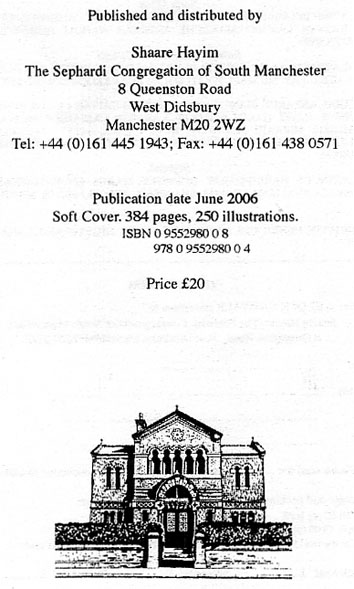Books

THE SEPHARDIM OF MANCHESTER. PEDIGREESAND
PIONEERS
By Lydia Collins
In collaboration with Morris L. Bierbrier FSA
Manchester has been home to the Sephardim for a hundred
and fifty years, the only major Sephardi settlement in Great
Britain outside London. They were drawn to Manchester, the
centre of the Lancashire textile trade, from the early nineteenth
century and over the next hundred years their numbers grew
until the city was able to support three Sephardi synagogues.
Many belonged to long-established merchant families in the
Mediterranean and Middle East. Their international trade
was based largely on kinship networks. With a branch at
the source of supply in Manchester acting as agents for
relatives back home and often other branches in Egypt and
Central and South America. Manchester was seen as a symbol
of prosperity and in Aleppo it was the custom to add the
words "…and may he live in Manchester'' to the
traditional circumcision blessing of infant sons.
THE SEPHARDIM OF MANCHESTER brings together for
the first time the pedigrees of more than 100 families associated
with Manchester and contains over 10,000 names. Using private
family sources and new research in unpublished archives
in Britain and overseas it also traces many families before
their arrival in Manchester and branches in other countries.
The pedigrees are arranged according to area of origin reflecting
the diversity of the community. There are explanatory notes
and sources, and cross- references to illustrate the many
intermarriages between families. Within its pages will be
found isaac Belisha, first President of the community and
grandfather of Lord Hore-Belisha who as Minister of transport
introduced the Beligha beacon to Britain's roads; Michele
Besso. Collaborator with Albert Einstein on the formulation
of the theory of relativity; the society photographer Baron;
Maxwell Setton, producer of "I was Monty's Double''
and other films; and Victoria Kamhi, wife and amanuensis
of the blind Spanish composer Joaquin Rodrigo. The book
throws new light on the background of the writer Elias Canetti,
winner of the Nobel Prize for literature, and his wife Veza;
and on the career of the artist Charles Spencelayh RA.
Copiously illustrated, the wealth of data contained within
this work will be of interest to family historians and provide
a rich source of material for further search by students
of serial and business history.

If
you would like to make any comments or contribute to The
Scribe please contact
us.